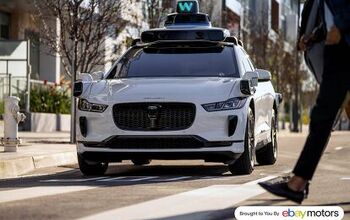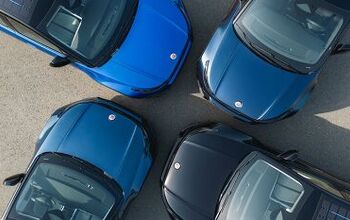Selling My 2004 Mazda MX-5 Miata Was Remarkably Difficult, and Also Remarkably Easy
There comes a point in the lives of most MX-5 owners when an inevitable question is asked. How do you solve a problem like Miata?
In my case – which is similar to many Miata owners, at least according to Miata lore – the Mazda itself is certainly not the problem. Acquired in May 2017 and driven 5,000 miles over the course of 8 months, the Miata’s only costs involved around 200 gallons of premium fuel, a few hundred bucks for insurance, two oil changes, two MVIs, some Autoglym convertible top maintenance spray, and a headlight defogging kit.
Oh, and zero dollars in depreciation.
In 40 years, I may well look back on this 2004 Miata as the best car I ever owned. How does one replace such a car? Why does one replace such a car?
The problem, not surprisingly, boiled down to the lack of a rear seat. It’s not as though the Miata mysteriously lost its rear perch between May 2017 and July 2018. But last spring’s purchase took place when there was always a manufacturer-supplied press tester in my driveway. If a rear seat was required, I took the Acura TLX A-Spec, Mercedes-Benz E400 Coupe, Audi A4, Kia Rio, Lexus IS350, Volkswagen Tiguan, Ford Fusion Energi.
Access to vehicles remains easy for me, but it now requires foresight and planning, which isn’t so straightforward when the life of a young family takes unexpected turns. The simple task of picking up the kids at their grandmother’s on the way home from work was rendered impossible by the Miata, for example. More importantly, last summer’s beach forays with our three-year-old often occurred when the infant was being nursed to sleep. That infant is now a toddler, looking out the living room window as his big brother gets to go out for a drive.
It therefore became obvious in the early spring, while the car was still covered up in the back of the garage, that it was time for the Miata to go. But early interest in the car caused me to waver, and I ended up daily-driving the Mazda into July before a coworker found me the right buyer.
Making the selling process a predictable pain were too many low-ballers hoping for a 25-percent discount, too many people expecting an ’04 to be absolutely perfect, too many buyers unaware that the Miata is small, and too many spouses who couldn’t agree. In the end, a female Subaru Forester owner added the Miata as a summer car.
Aghast at the number of convertible drivers who leave roofs up when it’s not raining, I drove the Miata with the top-down no matter the temperature – heaters exist for a reason. I was pleased to discover that the Miata’s new owner takes a similar approach to roadster ownership. Two weeks into Miata ownership, she’s only briefly explored what it’s like to drive the car with the roof up. (Which, to be frank, is rather miserable.)
Replacing the Miata was easier than I expected, though the enthusiast tendency to automatically reject normal, mainstream, obvious vehicles severely limits options. We knew a back seat was mandatory, and it became clear over the weeks of searching, before and then immediately after losing the Miata, that an automatic transmission was going to sap a lot of life’s joys.
Should we buy a decade-old Jeep Wrangler, perfect for combining topless summertime fun with an ability to handle deep snow? What about a 2008 BMW 328xi Coupe, with exemplary driving manners and PEI-friendly all-wheel drive? An early Toyota FJ Cruiser would break the budget, but FJ depreciation seems to have reached its terminus. Back at the other end of the spectrum, a clean BMW 128i would be fun. An unmolested Volkswagen Golf GTI could be ideal, if such a car existed.
Instead, I stuck more closely to the spirit of the Miata by acquiring an Ultramarine 2013 Scion FR-S for USD $11,250. Serviced at the dealer, free of squeaks and rattles, with 32,000 miles under its belt, new tires, and a handful of touched-up stone chips on the hood, the FR-S comes across as downright refined and powerful after 14 months in an old Miata.
Yes, everything is relative.
Observed fuel economy bizarrely matches the Miata’s 32.2 U.S. mpg. (My commute includes two sets of lights, no traffic, and an eco-minded cruising speed of 55 mph.) The 200-horsepower 2.0-liter Subaru boxer four is happier to rev than I recalled from earlier drives. The delightful six-speed’s ratios are more appropriate for daily driving than the Miata’s. The balance, the involving rear end, the way the weighty steering lightens up, and the ride quality all deserve high praise.
Meanwhile, the boys, at least for another year or two, can be squeezed into the back thanks to narrow Diono Radian child seats.
Now comes the arduous challenge of proving my closest acquaintances wrong by keeping the FR-S for more than 14 months.
[Images: Timothy Cain/TTAC]
More by Timothy Cain
Latest Car Reviews
Read moreLatest Product Reviews
Read moreRecent Comments
- Ajla The market for sedans is weaker than it once was but I think some of you are way overstating the situation and I disagree that the sales numbers show sedans are some niche thing that full line manufacturers should ignore. There are still a sizeable amount of sales. This isn't sports car volume. So far this year the Camry and Civic are selling in the top 10, with the Corolla in 11 and the Accord, Sentra, and Model 3 in the top 20. And sedan volume is off it's nadir from a few years ago with many showing decent growth over the last two years, growth that is outpacing utilities. Cancelling all sedans now seems more of an error than back when Ford did it.
- Duties The U.S . would have enough energy to satisfy our needs and export energy if JoeBama hadn’t singlehandedly shut down U.S. energy exploration and production. Furthermore, at current rates of consumption, the U.S. has over two centuries of crude oil, https://justthenews.com/politics-policy/energy/exclusive-current-rates-consumption-us-has-more-two-centuries-oil-report.Imagine we lived in a world where all cars were EV's. And then along comes a new invention: the Internal Combustion Engine.Think how well they would sell. A vehicle HALF the weight, HALF the price that would cause only a quarter of the damage to the road. A vehicle that could be refueled in 1/10th the time, with a range of 4 times the distance in all weather conditions. One that does not rely on the environmentally damaging use of non-renewable rare earth elements to power it, and uses far less steel and other materials. A vehicle that could carry and tow far heavier loads. And is less likely to explode in your garage in the middle of the night and burn down your house with you in it. And ran on an energy source that is readily extracted with hundreds of years known supply.Just think how excited people would be for such technology. It would sell like hot cakes, with no tax credits! Whaddaya think? I'd buy one.
- 3SpeedAutomatic I just road in a rental Malibu this past week. Interior was a bit plasticity, but, well built.Only issue was how “low” the seat was in relation to the ground. I had to crawl “down” into the seat. Also, windscreen was at 65 degree angle which invited multiple reflections. Just to hack off the EPA, how about a boxy design like Hyundai is doing with some of its SUVs. 🚙 Raise the seat one or two inches and raise the roof line accordingly. Would be a hit with the Uber and Lyft crowd as well as some taxi service.🚗 🚗🚗
- Dartdude Having the queen of nothing as the head of Dodge is a recipe for disaster. She hasn't done anything with Chrysler for 4 years, May as well fold up Chrysler and Dodge.
- Pau65792686 I think there is a need for more sedans. Some people would rather drive a car over SUV’s or CUV’s. If Honda and Toyota can do it why not American brands. We need more affordable sedans.



































Comments
Join the conversation
BMW 328ix Cabrio seems not to exist, so A4 or A5 Cabrio quattro could be next?
Great to hear from you, Tim! I hope you can drop in soon to let us know how the FR-S is treating you. Miss having you as a regular contributor.